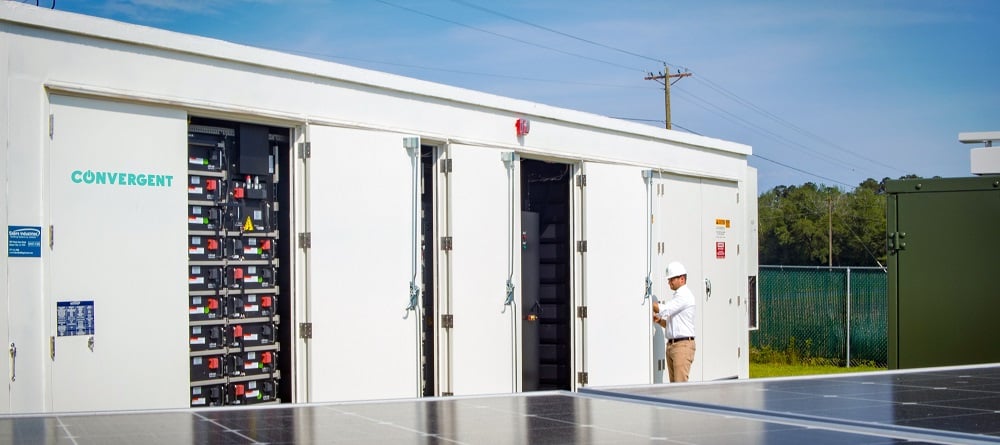How Energy-Intensive Businesses in New England can Mitigate Rising Energy Costs

Renewable energy systems, such as home electrification and the adoption of electric vehicles, are increasing demand for power, as the distribution and transmission system upgrades only add to prices. The cost of transmission alone is anticipated to increase almost 25% by 2028.
In this blog post, we will cover what's behind rising energy costs in New England and how on-site renewable energy systems—including energy storage and solar photovoltaics (PV)—can help businesses cut costs and reduce environmental impact without negatively impacting operations or growth.
What’s Driving New England’s Rising Energy Costs?

Rising energy prices can be attributed to a combination of factors. In New England, specifically, these factors include:
⚡ Increased Energy Demand: As the demand for electricity rises—especially during peak periods—the strain on the power grid intensifies. Driven in part by increased home electrification–i.e., moving to electric heating–New England predicts winter peak load will be 31% higher in 2032-2033 than in 2022-2023.
🏋️ Global Supply Chain Issues Impacting Large Renewable Generation Projects: Global supply chain dynamics, coupled with inflationary pressures, continue to cause procurement challenges, and ultimately are raising prices for utilities (and customers!).
💲 High Cost of Fossil Fuels: The prices of fossil fuels—such as natural gas and oil—often play a significant role in determining energy costs. Natural gas supplies almost half of New England’s electricity, and oil and is relied upon during the most expensive hours on the electric grid. When natural gas supplies are limited, or most in-demand (i.e. cold weather), prices further increase and fluctuate.
How New England Businesses Can Mitigate Rising Energy Costs with Energy Storage and/or Solar PV
For businesses looking to mitigate rising energy costs—or hedge against future cost increases—energy storage is an optimal solution.
Energy storage systems allow electricity to be stored—and then discharged—at the most strategic times. Today, Lithium-ion batteries, the same batteries that are used in cell phones and electric vehicles, are the most commonly used type of energy storage. Like the batteries in your cell phone, commercial-, industrial-, and utility-scale battery energy storage systems can be charged with electricity from the grid, stored, and discharged when there is a deficit in supply or when energy is most expensive. When battery storage is paired with solar PV (known as solar-plus-storage), industrial-scale batteries can discharge solar energy whether or not the sun is shining.
Battery storage or solar-plus-storage does not replace a utility provider. Rather, it locks in a fixed, lower price for more sustainable electricity through a Power Purchase Agreement (PPA). This CapEx-free partnership structure allows businesses to reduce their carbon footprint with no impact on operations.

Further, as businesses look for GHG-free ways to lower electricity costs and reach sustainability goals, on-site renewables provide a win-win opportunity. This “win-win” is one of the reasons people are calling this “The Battery Decade,” and the U.S. energy storage market is projected to grow to more than $100 billion over the next 10 years.
As the world increasingly looks to renewable resources and away from fossil fuels, battery storage can help bridge this energy transition. Again, the more renewable energy on the grid, the better—but these resources only produce power when the sun is shining, or the wind is blowing. Battery storage can “firm up” renewable resources, maximizing their value to the grid—and to you.
How to Get Started with Energy Storage or Solar-Plus-Storage
If your business is considering a battery storage or solar-plus-storage solution to help meet your sustainability goals, lower your energy bill, and hedge against rising energy costs, you are in good company. Businesses like Shell, Ford, and National Grid have done just that with a development partner (spoiler alert: that partner is Convergent Energy and Power).
Convergent Energy and Power (Convergent) is a leading provider of energy storage and solar-plus-storage systems across North America. For over a decade, Convergent has gained deep expertise by working closely with industrial businesses to take the hassle out of on-site renewable solutions by building, owning, and operating systems on customers’ behalf. Once again, we finance the system, so there is no interruption to operations and no CapEx required on the part of our customers.
Escalating wholesale electricity prices and the increased demand for power in New England highlight the increasing value of battery storage and/or solar PV.
If you’re ready to lower your energy bill and carbon footprint, schedule a free, no-obligation introductory call with our team today.


